List of Authors
>>About this blog
Recent blog post
|
[Hanes]
January 6, 2019 09:00
Hello. This is a new correspondent, Hanes. 
This time, we will take up the landfill of rivers in the final round of [Chuo-ku Tourism Certification Measures] River and Bridges.
(Click here for previous articles → (1), (2), (3))
Due to many rivers and diggings, the current Chuo-ku has been called the "city of water" since the Edo period.
However, over the years, rivers have been reclaimed, and their remnants can be known from the information boards and the remaining main pillars.
When and what was landfilled, and how the town changed?...
If you remember such things like 5W1H, you can connect events with each other in a causal relationship.
The history of the development of Chuo-ku will be easier to come to mind. 
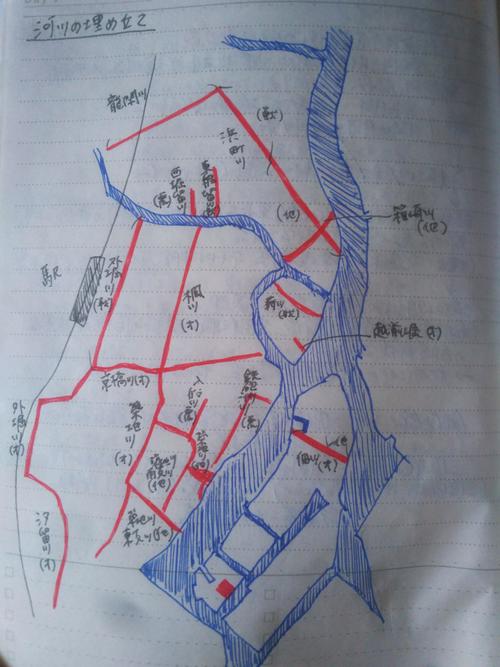
(↑ Page 1 of the countermeasure note at the time of last year's test inspection)
The events that triggered river reclamation can be broadly divided into the following four categories.
Earthquake reconstruction, war reconstruction, Tokyo Olympics, etc.
■Earthquake reconstruction
The Irifune River, the Tepposu River, and the Nishibori Ru River (Isecho Hori) were reclaimed at this early stage.
■Reconstruction of war
At that time, there were no vehicles or fuels carrying surplus soil or debris.
Therefore, rivers that are not very necessary as waterways are reclaimed with residual soil and debris to create land and create land.
The Tokyo Metropolitan Government's debris disposal measures were implemented to sell it and generate operating costs.
That was the landfill, and the northern half of the outer moat River and the Sanjuken River disappeared at this time.
■Tokyo Olympics (1964, 18th)
In preparation for the Olympics, highways, subways, and arterial roads were urgently developed.
Therefore, the Tsukiji River and Kaede River were reclaimed, and the capital height centered on Route 1 (4.5 km between Kyobashi and Shibaura) was constructed, and the Tsukuda River was reclaimed by the bridge of Tsukuda-ohashi Bridge (1964). Was.
However, because it was reclaimed too quickly, it was impossible to drain rainwater. 
Therefore, pumping stations of the Tokyo Metropolitan Sewerage Bureau were set up in Hamacho, Nakasu, and Hakozaki-cho.
<Aside>
The torch relay course is 1.5km between Kiyosu Bridge and Kayaba Bridge.
It was 2.0 km between Kayababashi and Kajibashi.
You don't have to remember in particular about river reclamation, but you don't have to worry about it.
If you know it, you will surely enjoy walking around the town.
※In this article, we will introduce some of the reasons for this.
If you learn the contents written here, you will not be able to pass it.
Please include it in advance.
Valuable Information| Ningyocho, Hamacho, Higashinihombashi area| Tsukuda, Tsukishima, Kachidoki and Harumi areas| Nihonbashi, Kyobashi and Yaesu areas| History, culture| Tsukiji, Shintomi, Minato area| Kayabacho, Hatchobori, and Shinkawa areas| Ginza area
Page top▲
[Hanes]
January 5, 2019 18:00
Hello. This is a new correspondent, Hanes. 
Although it has been a little vacant, it is a continuation of [Chuo-ku sightseeing certification measures] river and bridge.
(Click here for articles on rivers and bridges so far → (1) and (2))
This time, it is said that the junction of the three rivers, the bridge before and after that, and the four bridges are featured.
First of all, about the confluence of the three rivers and the bridge before and after that.
Suddenly, it's a problem!
・What is the first bridge to be built after the Nihonbashi River joins the Sumida River?
・Where is the Nihonbashi River divided into the Kamejima River near (place name)?
・What is the first bridge to be built after the Kamejima River joins the Sumida River?
I don't dare to answer this time, but those who can't answer the above problem suddenly.
Why don't you check before the test?
Next, it is said that the characteristics of the bridge 4 can be effectively remembered by actually seeing, writing (drawing)!
■Sumida River
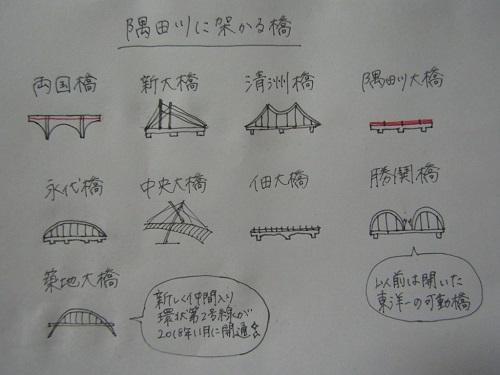
(Even if you don't have a picture, you won the game  if you can input the characteristics.) if you can input the characteristics.)
・Ryogoku Bridge (bridged after the great fire of the Meiryaku era. At that time, "Ohashi". Origin of bridge name → (1)
・Shinohashi ("Human Helping Bridge" that saved the lives of the people of Hashigami after the Great Kanto Earthquake)
・Kiyosu Bridge (a suspension bridge in Cologne, Germany) is modeled. Origin of bridge name → (1)
・Eitai Bridge (bridge to celebrate the 50th anniversary of Tsunayoshi Tokugawa's fifth generation. Japan's first steel truss bridge as a road bridge.
A tram was laid in 1904.
・Chuo-ohashi Bridge (between Shinkawa and Tsukuda. There is a "Messenger statue" commemorating friendship with Paris and Seine. )
・Tsukuda-ohashi Bridge (bridged in 1964 instead of Tsukuda's ferry). Tsukuda Bridge was removed due to the reclamation of the Tsukuda River. )
・Kachidokibashi (at the time of completion, it is called "the best movable bridge in the Toyo" and jumps five times a day.
In 1905, it began with a Kachidoki handed over to commemorate the fall of Port Arthur in the Russo-Japanese War. )
・Tsukiji Ohashi (a new bridge where Ring Route 2 passes.)
■Nihonbashi River
・Toyomi Bridge (It was also called Otome Bridge at the time of the bridge in 1698. The design looks like a ladder beside it.
The surrounding scenery is also described in Kitahara Hakushu's "Okawa Scenic" and Kafu Nagai's "Shokutei Nijo". )
・Minato Bridge (between Shinkawa and Hakozaki. The origin of the bridge name is that it corresponds to the entrance of Edo Minato.
・Kayaba Bridge (In the past, Minamizume was the shore of Kayaba (a storage area where kaya is cut and piled up), which is the origin of the bridge name.)
・Armor Bridge (a streetcar ran in Taisho-Showa. "Maison Konosu" and "Armor handing" are required. )
・Edobashi (Edobashi Hirokoji was maintained after the great fire of the Meiryaku era. In the Edo period, small shops gathered.
・Nihonbashi (bridged in 1603. The following year, it was the starting point of Gokaido. Check the 4 Hashizume Square!
・Nishi Riverside Bridge (the stage of Kyoka Izumi's masterpiece "Nihonbashi")
・Ichiishi Bridge (bridged as a wooden bridge in the early Edo period). Check the origin of the bridge name.
・Tokiwa Bridge
・Former Joban Bridge (Tokiwabashi Gate, one of the "Edo Goguchi" leading to Edo Castle front Otemon during the Edo period.)
・Shin-Tokiwa Bridge
■Kamejima River
・Reigishi Bridge (between Kayabacho and Shinkawa. In the Edo period, it was a low-marsh area full of reeds.
・Shin-Kameshima Bridge
・Kameshima Bridge (between Hatchobori and Shinkawa. Bridge in 1699. The current bridge is from 2002.
・Takahashi
・Minami Takahashi (reused part of the former Ryogoku Bridge). As a steel-frame bridge in the Meiji period existing in Tokyo
It's the second oldest after the old Dansho Bridge.
■Asashio Canal
・Asashio Ohashi, Asashiobashi, Harutsukibashi
・Triton Bridge (a moving path with a roof!)
・Reimei Bridge (Harumi-dori St. passes, parallel to Triton Bridge)
・Reimei Ohashi (a new bridge where Ring Route 2 passes.)
・Asashio Kobashi (approximately 113m bridge completed in 2003. Bicycles and pedestrians only.
■Other bridges
・Tsukuda Kobashi (bridged when Tsukuda Island is completed. Under the bridge, there is a large flag pillar used at the main festival of Sumiyoshi-jinja Shirine.
It is buried at the bottom of the river to prevent corrosion.
・Yanagibashi (Begins with a wooden bridge built by the old town. The Eitai Bridge is modeled.
It is also described in Kafu Nagai's "Peony Guest" and Riichi Yokomitsu's "Crest". )
・Shipping Bridge (it was over the Kaede River). In Higashizume, there is the residence of Shogen Mukai, the head of the Edo shogunate Mifune.
It was also called "Shogen Bridge" or "Pirit Bridge". )
The bridges introduced this time are not all, but each bridge has interesting episodes.
When walking around the town, check the information board at the side of the bridge. 
It may contain detailed information that is not available in the text, so it will be a study!
※In this article, we will introduce some of the reasons for this.
If you learn the contents written here, you will not be able to pass it.
Please include it in advance.
Valuable Information| Ningyocho, Hamacho, Higashinihombashi area| Tsukuda, Tsukishima, Kachidoki and Harumi areas| Nihonbashi, Kyobashi and Yaesu areas| History, culture| Tsukiji, Shintomi, Minato area| Kayabacho, Hatchobori, and Shinkawa areas
Page top▲
[Hanes]
December 29, 2018 09:00
Hello. This is a new correspondent, Hanes. 
This time, we will focus on songs and catchphrases, and introduce useful information for Chuo-ku sightseeing certification measures!
First of all, it's a song, but I don't say you should remember everything.
At least, let's keep the lyrics, composition, singers (if you have a representative person), and singing lyrics!
(If you can afford it, it may be a good idea to keep the performance of the lyricist / composer and the lyrics of other parts.)
■Willow in Ginza
Lyrics: 80 Saijo, composed: Shinpei Nakayama
"♪) Remnants of Yanagi Edo in Ginza who are happy to plant"
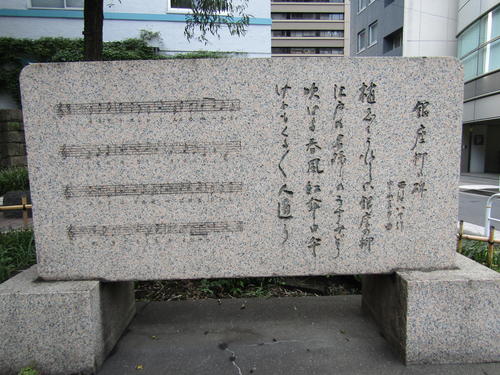
[Related Articles] [4th Excursion Series] The edge of Ginza's Yanagi Nisei's in Ginza
■This is Edo's Bon Dance
Lyrics: Toyohisa Araki, composed: Shosuke Ichikawa
"♪) Ha ~ This is a little dance in the middle of Tokyo, Bon Dance"

[Related Articles] Rediscover the charm of Chuo-ku! Bon Odori in Hatchobori and Kyobashi
■The story of love in Ginza
Lyrics: Hisao Otaka, composed: Kaburagi Sou, Song: Yujiro Ishihara, Junko Makimura
"♪) (female) a whispering that numbs to the bottom of the heart (male) a breathless sigh."
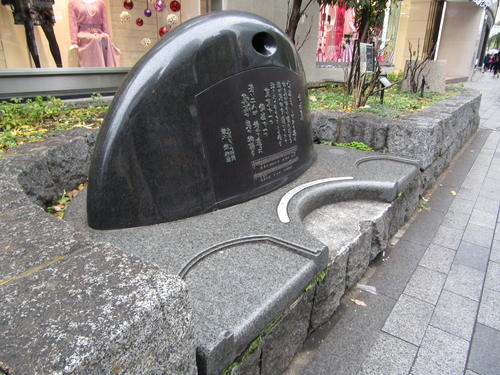
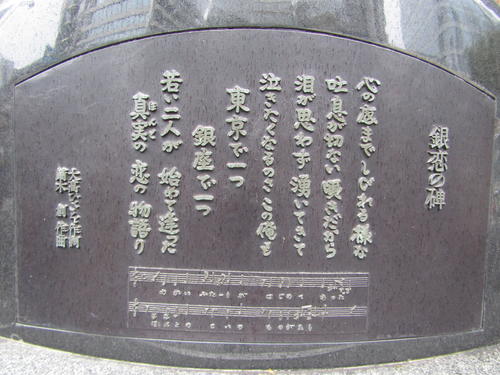
[Related Articles] Dimini ☆Mr. Cricket "The tour of poetry monument in Ginza"
■Bon Dance Song of Tsukuda Island
This Bon Odori is characterized by a monotonous rhythm turret drum and an oral song like a memorial Buddha.
It is sung as "Autumn field separation is an impermanent wind, if it scatters, everyone will not remain, and if it is enlightened, the vegetation will be the land, and the Buddha will be the southern Amitabha Buddha."
Next is the catchphrase, etc.
■Mitsukoshi Nihonbashi Main Store
Click here for a copy of the advertisement that was featured on the flyer of Japan's first Western-style theater "Imperial Theater"!
"Today is the Imperial drama tomorrow is Mitsukoshi,"
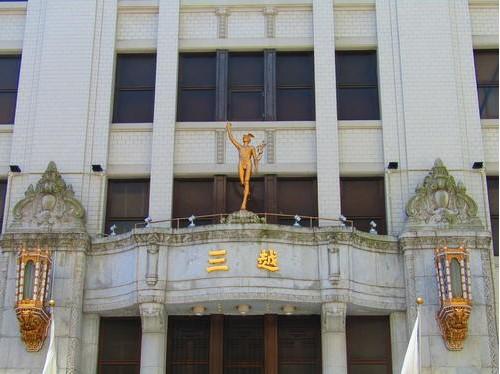
■Takashimaya Nihonbashi Store
The store newly built in 1993 (2 basement floors and 8 floors above ground) was designed by Sadataro Takahashi.
The entire building is fully equipped with air conditioning and heating, and here is a popular advertising copy!
"It's hot in Tokyo, where I left Takashimaya."
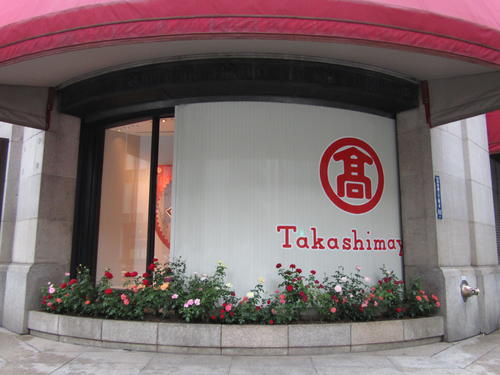
(The state of Takashimaya just before the opening of the store)
■Nihonbashi Fish Bank
Along with the daytime playhouse and Yoshihara at night, it was called "a place where a thousand cars fall in one day."
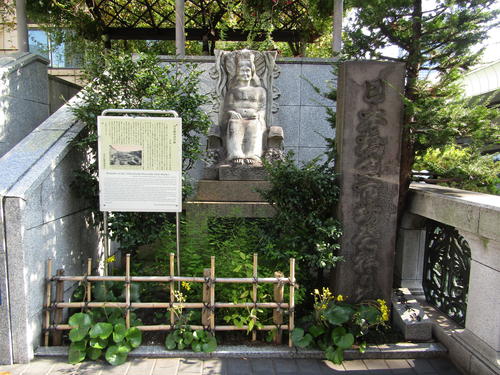
[Related Articles] "Chuo-ku x Spain (2)-Nihonbashi seen by Rodrigo-", "[9th excursion series] Island connected by fishermen"
■Suitengu Shrine
In the Edo period, there were many people who threw money through fences....
Therefore, only on the 5th day, the Arima family's residence was opened to the general Edo kid, making it possible to worship.
It came to be called like this
"Suittengu of the mercy,"
[Related Articles] Sam "2018 Suitengu Setsubun Festival", Edamame "Daughter Azuki's Shichigosan, 3: Visit at Suitengu. (Half, anti-professional)."
■The town of Edo where wooden houses are densely packed
As typified by the great fire of the Meiryaku era (January 18, 1657), there are very many fires in the town of Edo.
It was said, "Fire and fight are the flowers of Edo."
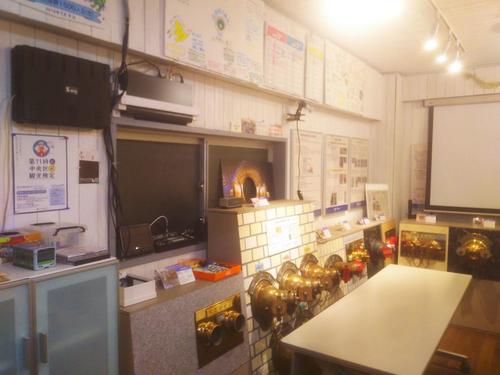
(With the kindness of the director of the water entrance museum, Minato-ku also puts a flyer for the Chuo-ku sightseeing certification and promotes it! Thank you very much . .
[Related Articles] "Chuo-ku in the History of Fire Fighting (Part 1)"、"Chuo-ku in the History of Fire Fighting (Part 2)"
■Gas lamps
In 1874, the brightness of the 85 gas lamps lit in Ginza was expressed as follows.
"I changed the night to day,"

■A lantern
The work of Seibo Kitamura, which was installed at Sukiyabashi Park as a memorial tower for the 10th anniversary of the Great Kanto Earthquake.
A statue of a young man wearing a helmet holding a torch and watching a lion.
Even though it is small, the strength is transmitted.
What is written on the bronze casting nameplate of the pedestal is "continuous preparation for unexpected earthquakes."
[Related Articles] Yotaro "Around the Earthquake Reconstruction Memorial Tower Seibo Kitamura" Lighthouse "", GPP "I visited Seibo Kitamura's work (Lighthouse & Peace Memorial Statue)"
■Edo kid temperament (Kyoden Santo)
"I saw the killer whale of Edo Castle and made tap water as a hot spring." "I don't have any money for evening."
"Food and play equipment are luxurious" and "Natural Edo no Hanuki"
Let's also check "Ikito Harima is the main territory"
■Nihonbashi
The magazine "Remarks in Gofunai" compiled by the Shogunate states, "This bridge is in the center of Edo, and the process of the countries is determined here, so Nihonbashi's name is Tofu."
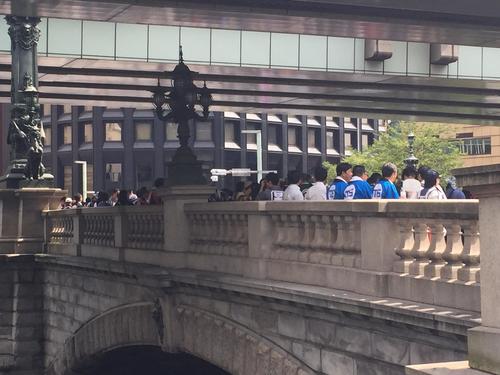
How did you like that?
These are not all songs and catchphrases related to Chuo-ku, but they are not all.
Like the previous Haiku and Kawayanagi, there are many impressive things.
When walking around the town, be sure to check these out.
※In this article, we will introduce some of the reasons for this.
If you learn the contents written here, you will not be able to pass it.
Please include it in advance.
[Hanes]
December 28, 2018 18:00
Hello. This is a new correspondent, Hanes. 
The date of the Chuo-ku Tourism Examination Examination is approaching, but is your study progressing smoothly?
This time, I will introduce you to visiting historical sites in Chuo-ku, which also serves as a measure against Haiku and Kawayanagi.
■Mrs. Takeko Kujo, poetry monument
She was born in Kyoto as the second daughter of the gatekeeper of Nishi Honganji Temple and married Baron Yoshiyuki Kujo at the age of 21.
My husband has been living separately for nearly 10 years due to studying and working in the UK.
During that time, I studied Waka (Nobutsuna Sasaki), Painting (Shoen Uemura), and Ikebana (Nishikawa Ikusatei) and refined my talents.
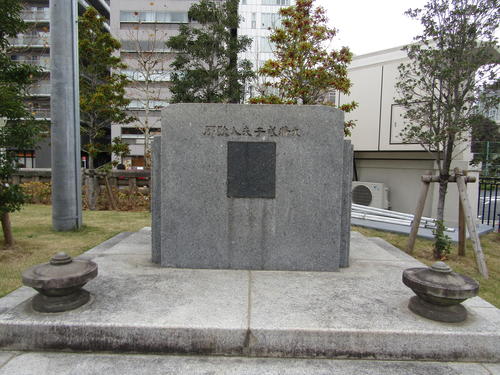
The songbooks she left include "Kinsuzu" and "Kaosen" and the essay "Muyuka".
I would like to keep in mind the "Overy Things I'm going to be drawn from the great things" engraved on poetry monument in Tsukiji Honganji Temple.
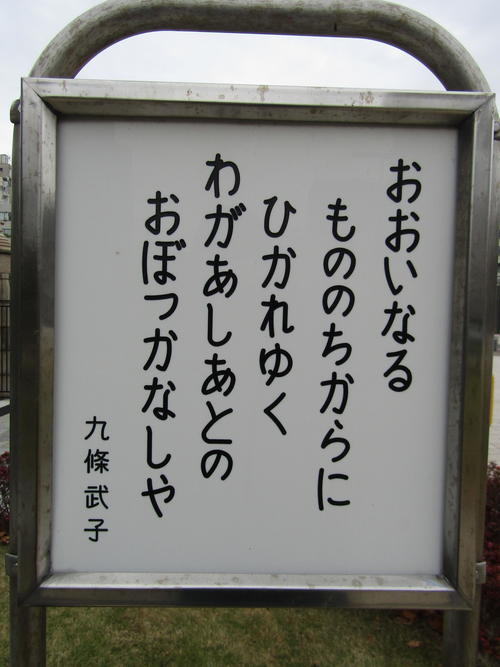
■Kawayanagi, Mizutani Ryotei stone monument
His phrase, worried about the customs of Tsukuda Island and talked about Setsuyoshi Tadataka at home, can be seen on the grounds of Sumiyoshi-jinja Shirine.
"I'm a gentle and hard man,"
■Bronze bell at the time of Kokumachi
This bell was installed in Honishi-cho during the time of the second shogun Hidetada Tokugawa, informing the people of Edo Castle of the time.
Because there was Nagasakiya (Dutch trading post's post office) nearby, Kawayanagi was written....
"I can hear the bell of Kokumachi to the Netherlands."
■poetry monument Takuboku Ishikawa
He joined the Asahi Shimbun in Takiyamamachi, Kyobashi-ku (currently Ginza 6-chome).
For about three years until he died at the age of 26 due to pulmonary tuberculosis, etc., he worked as a proofreader while working as a proofreader.
"Iss of the time when I became a newspaper light in Takiyamamachi in Kyobashi"
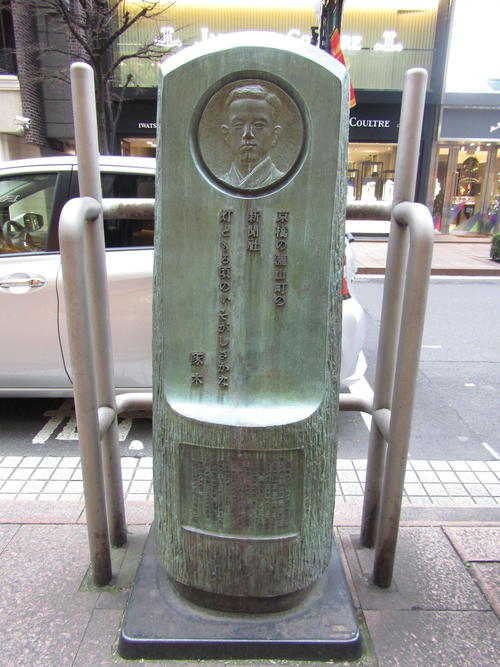
In addition, his first songbook, "A handful of Sand," begins with "Crying up by the white sand of the shores of Kojima in Tokai and hitting crabs."
■Echigo-ya
Enomoto (Takarai), one of the Juetsu Shomon and a representative of a group called Edoza (which features a flashy phrase that reflects the Edo kid's temperament), wrote such a phrase about Echigoya. .
"Echigo-ya's sound and clothespin,"
The scene seems to suddenly come to my eyes.
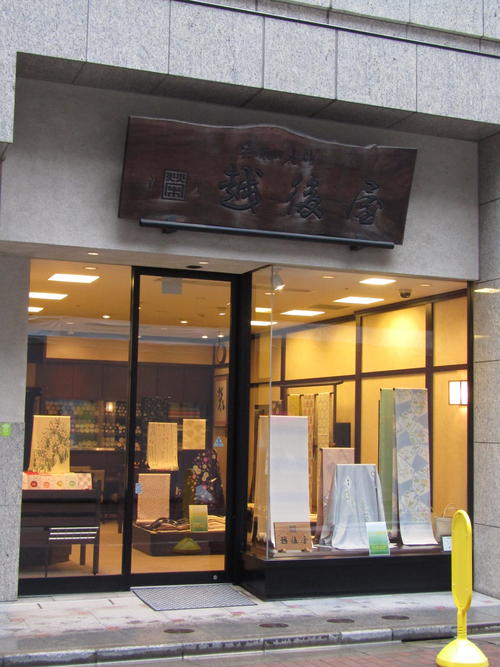
It's a great deal, so let's remember the other phrases at the corner together.
(We will not explain in detail here, but we recommend that you also check the background where each phrase is written!)
"The path of the crane is as expected in the spring of the sun."
"There is no day when one bell can't be sold, spring in Edo"
"I wonder if this number of boats will be cool."
■Site of Kaikaikan
Kaikaikan, which opened in 1905, is a two-story wooden ryokan in Kappo cuisine, which was relocated from Sendai City.
At that time, this area was a scenic and quiet place with a panoramic view of Tokyo Bay, so famous cultural figures stayed there.
The following is a summary of the Kaikaikan:
"Let's see the winter sea and make the New Tsukuda Sea Water Museum wabi live."
(From Isamu Yoshii's songbook "Poison Utsugi")
■19 tombs
On the left side of his tomb (Shinenzan Toyo-in), the creator of Tokaido Naka-Kurige, is located.
The phrase of a famous dictionary is engraved.
"Goodbye to ashes with the smoke of incense stick in your spare time."
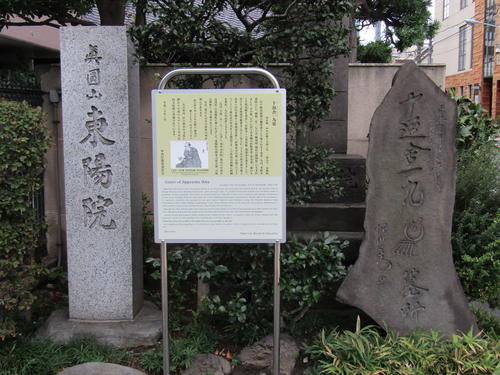
■The end of Shoin Yoshida
Despite being an excellent man who raised many of the late Tokugawa shogunate soldiers, his resignation phrase, executed in the Kodemmacho prison, is set up in Kodemmacho.
"The body is kept in the Nobe of Musashi even if it does not decay,"
■Sushi
Such a phrase was written because the hand of the craftsman holding the sushi resembles a spell of ninjutsu.
"Vinegar rice held by the body of magic" (Kawayanagi haiku collection "Shufu Yanagi Taru")
I've picked up Haiku and Kawayanagi so far.
All of them are impressive things that are memorable.
If you have a phrase you don't know, why not check it before the test?
※In this article, we will introduce some of the reasons for this.
If you learn the contents written here, you will not be able to pass it.
Please include it in advance.
Valuable Information| Ningyocho, Hamacho, Higashinihombashi area| Tsukuda, Tsukishima, Kachidoki and Harumi areas| Nihonbashi, Kyobashi and Yaesu areas| History, culture| Tsukiji, Shintomi, Minato area| Kayabacho, Hatchobori, and Shinkawa areas| Ginza area
Page top▲
[Silver]
December 16, 2018 18:00
The canal facing Harumi Island Triton Square is called the Asashio Canal.
From the downstream, this canal is Asashio Kobashi, (there is a morning tide gate), Reimei Ohashi (Ring Route 2), Reimei Bridge, and Triton Bridge. On the Chuo-ku sightseeing guide map on hand, Harutsuki Bridge, Asashiobashi, and Asashio Ohashi are listed in the order of then. On this map, a narrow two-line line is drawn between Reimei Bridge and Harutsuki Bridge, which is a bridge dedicated to the Asashio Canal (Asao Ungasenyobashi) was bridged in the early 1960s. It was done and is open to the general public.
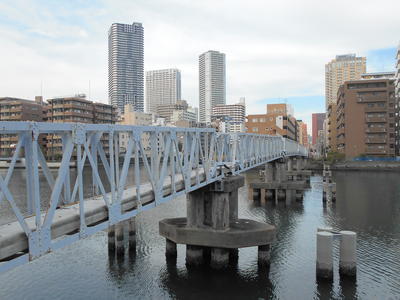
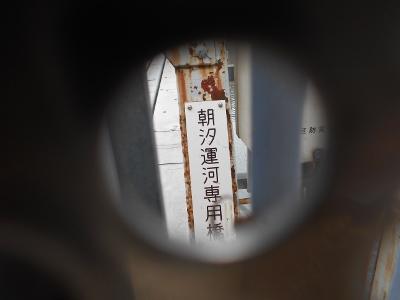
Recently, when I took a walk, I learned that a new bridge was bridged. It was written as Sakura Kobashi. It was built between "Triton Bridge" and "Asashio Canal Bridge" on October 1, 2017.
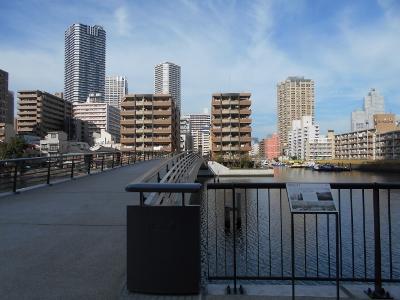
"Sakura Kobashi" is a pedestrian-only bridge connecting Kachidoki 2-chome and Harumi 1-chome, and is said to have been built to reduce pedestrian congestion during the morning and evening commuting rush.
Also, next to Sakura Kobashi, there is an explanation board describing the history of the Asashio Canal, so please take a look.
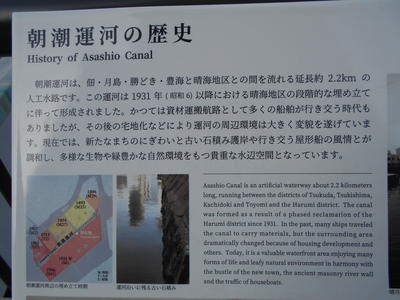
[Sam]
December 16, 2018 18:00
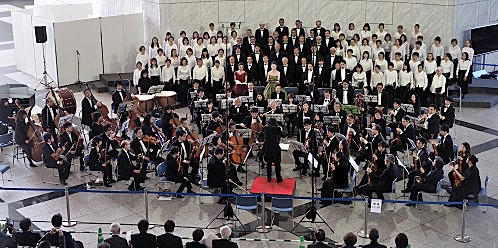 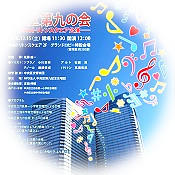 Shiwasu's annual "Beethoven Ninth Concert". From 12:00 on December 15th, at the Grand Lobby Special Venue on the 2nd floor of Harumi Triton Square, the 12th Triton Square performance of "Chuo-ku Ninth-no-kai" conducted by Yuichi Sato, was held this year. . Shiwasu's annual "Beethoven Ninth Concert". From 12:00 on December 15th, at the Grand Lobby Special Venue on the 2nd floor of Harumi Triton Square, the 12th Triton Square performance of "Chuo-ku Ninth-no-kai" conducted by Yuichi Sato, was held this year. .
The Chuo-ku Ninth Association is composed of the Chuo-ku Ninth Memorial Choir organized in 2007 and the Chuo-ku Symphony Orchestra established in 1994, mainly for those who live and work in Chuo-ku. All amateurs.
The first part is the opening fanfare by the Chuo-ku Symphony Orchestra, the chorus by the Chuo-ku Tsukishima Daiichi Elementary School Choir, the chorus by the Chuo-ku Tsukuda Junior High School Volunteer Choir, and the chorus by the Chuo-ku Ninth Memorial Choir (Chuo-ku Ninth) Following the version "Edo Nihonbashi" etc.), the second part of the symphonic with Beethoven composition is the second part 9th. He was sung powerfully with Beethoven's thoughts on peace that "all humanity will be brothers" put in the ninth.
|
Links
|
![]()
![]()
![]()
![]()

![]()
![]()
![]()
![]()
![]()





















 Shiwasu's annual "Beethoven Ninth Concert". From 12:00 on December 15th, at the Grand Lobby Special Venue on the 2nd floor of Harumi Triton Square, the 12th Triton Square performance of "Chuo-ku Ninth-no-kai" conducted by Yuichi Sato, was held this year. .
Shiwasu's annual "Beethoven Ninth Concert". From 12:00 on December 15th, at the Grand Lobby Special Venue on the 2nd floor of Harumi Triton Square, the 12th Triton Square performance of "Chuo-ku Ninth-no-kai" conducted by Yuichi Sato, was held this year. .
